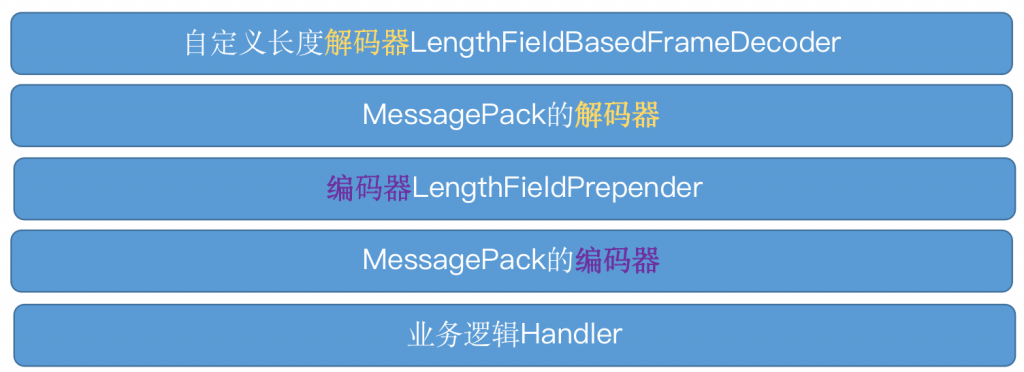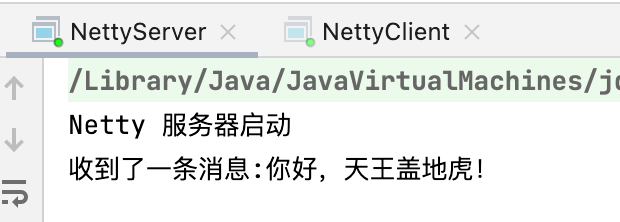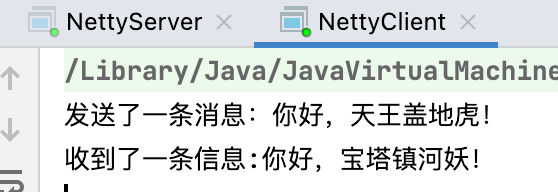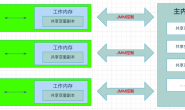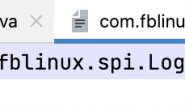1.编解码技术介绍
基于Netty的NIO网络开发,我们关注的重点之一是网络传输。当进行远程跨进程服务调用时,需要把被传输的Java对象编码为字节数组或者ByteBuffer对象。而当远程服务读取到ByteBuffer对象或者字节数组时,需要将其编码为发送时的Java对象。这被称为Java对象编解码技术。
Netty 自身提供了一些编解码器如StringEncoder和StringDecoder对字符串进行编解码,ObjectEncoder和ObjectDecoder对Java对象进行编解码,但是底层使用的是Java提供的序列化技术,由于Java自带序列化缺陷较多,衍生出了多种编解码技术和框架。业界和Netty结合使用的主流编解码框架有如下四种:
- MessagePack
- Protobuf
- Thrift
- JBoss Marshalling
本篇以Netty利用MessagePack为案例进行说明:
2.
MessagePack是一个高效的二进制序列号框架,它像JSON一样支持不同语言间的数据交换。
MessagePack优点:
- 支持跨语言,提供市面上绝大多数语言的支持;
- 使用非常的简单;
- 编解码高效;(相对于JDK原生的,比Protobuf差点意思)
- 序列化之后的码流小;
MessagePack解决的是实体对象的编解码问题,如果要解决粘包/拆包问题,我们需要使用专门的粘包拆包解码器。
3.配置思路
创建客户端、服务器端Handler初始化配置类思路:
MessagePack已经把消息转换成字节序列,我们使用自定义长度解码器LengthFieldBasedFrameDecoder 进行解码,我们需要在消息字节序列前面加上一个字节长度,这个可以直接利用Netty的LengthFieldPrepender编码器来处理,该编码器作用是自动获取字节序列总长度的值,然后在字节序列前面加上长度域,长度域中填写字节序列值。
所以Hander初始化配置类中的Handler的顺序如下:
4.代码实现
实现步骤:
1、pom.xml中增加MessagePack的依赖;
<dependency> <groupId>org.msgpack</groupId> <artifactId>msgpack</artifactId> <version>0.6.12</version> </dependency>
@Message
// 传输的实体对象
@Message
public class Information
{
//消息头
private short header;
//消息类型
private byte msgtype;
//数据内容
private String content;
public short getHeader()
{
return header;
}
public void setHeader(short header)
{
this.header = header;
}
public byte getMsgtype()
{
return msgtype;
}
public void setMsgtype(byte msgtype)
{
this.msgtype = msgtype;
}
public String getContent()
{
return content;
}
public void setContent(String content)
{
this.content = content;
}
}
ByteBuf,重写decode方法,
// 通过扩展MessageToMessageDecoder来自定义解码器,基于MessagePack的解码器,把byte数组反序列化为消息实体对象
public class MessagePackDecoder extends MessageToMessageDecoder<ByteBuf>
{
@Override
protected void decode(ChannelHandlerContext channelHandlerContext, ByteBuf byteBuf, List<Object> list) throws Exception
{
MessagePack messagePack=new MessagePack();
int intLength=byteBuf.readableBytes();
byte[] raw=new byte[intLength];
byteBuf.getBytes(byteBuf.readerIndex(),raw,0,intLength);
list.add(messagePack.read(raw,Information.class));
}
}
4、创建编码器,该解码器继承的是MessageToByteEncoder,类型为实体,如Information;重写encode方法;
// 通过扩展MessageToByteEncoder来自定义编码器
public class MessagePackEncoder extends MessageToByteEncoder<Information>
{
@Override
protected void encode(ChannelHandlerContext channelHandlerContext, Information information, ByteBuf byteBuf) throws Exception
{
MessagePack messagePack=new MessagePack();
//进行序列化(编码)
byte[] raw=messagePack.write(information);
byteBuf.writeBytes(raw);
}
}
5、创建客户端、服务器端handler,注意这里读取到的消息就直接是实体了;
客户端handler代码:
public class ClientHandler extends SimpleChannelInboundHandler<Information> {
@Override
protected void channelRead0(ChannelHandlerContext channelHandlerContext, Information info) throws Exception
{
System.out.println("收到了一条信息:"+info.getContent());
}
@Override
public void exceptionCaught(ChannelHandlerContext ctx, Throwable cause) throws Exception
{
// 处理I/O事件的异常
cause.printStackTrace();
ctx.close();
}
@Override
public void channelActive(ChannelHandlerContext ctx) throws Exception
{
//发送自定义协议格式的消息
Information info=new Information();
info.setHeader((short)0x5A5A);
info.setMsgtype((byte)0x01);
info.setContent("你好,天王盖地虎!");
System.out.println("发送了一条消息:"+info.getContent());
ctx.writeAndFlush(info);
}
}
服务器端handler代码:
public class ServerHandler extends ChannelInboundHandlerAdapter {
@Override
public void channelRead(ChannelHandlerContext ctx, Object msg) throws Exception
{
//读取消息,并按照自定义的协议格式进行消息的处理
Information in=(Information)msg;
System.out.println("收到了一条消息:"+in.getContent());
Information returnInfo=new Information();
returnInfo.setHeader((short)0x3C3C);
returnInfo.setMsgtype((byte)0x01);
returnInfo.setContent("你好,宝塔镇河妖!");
//发送消息
ctx.writeAndFlush(returnInfo);
}
@Override
public void exceptionCaught(ChannelHandlerContext ctx, Throwable cause) throws Exception {
cause.printStackTrace();
ctx.close();
}
}
6、创建客户端、服务器启动类代码,并添加相应pipeline
客户端启动类代码:
public class NettyClient {
private String host;
private int port;
public EchoClient(String host, int port) {
this.host = host;
this.port = port;
}
public void start() throws Exception {
EventLoopGroup group = new NioEventLoopGroup();
try {
Bootstrap bootstrap = new Bootstrap();
bootstrap.group(group)
.channel(NioSocketChannel.class)
.remoteAddress(new InetSocketAddress(host, port))
.handler(new ChannelInitializer<SocketChannel>() {
@Override
public void initChannel(SocketChannel ch)throws Exception {
//自定义长度解码器LengthFieldBasedFrameDecoder
ch.pipeline().addLast(new LengthFieldBasedFrameDecoder(1024,0,2,0,2));
ch.pipeline().addLast(new MessagePackDecoder());
ch.pipeline().addLast(new LengthFieldPrepender(2));
ch.pipeline().addLast(new MessagePackEncoder());
ch.pipeline().addLast(new ClientHandler());
} });
//连接到服务端,connect是异步链接,再调用同步方法sync,等待连接成功
ChannelFuture f = bootstrap.connect().sync();
//阻塞直到客户端通道关闭
f.channel().closeFuture().sync();
} finally {
//优雅退出,释放NIO线程组
group.shutdownGracefully().sync();
}
}
public static void main(String[] args) throws Exception {
new EchoClient("127.0.0.1", 8080).start();
}
}
服务器端启动类代码:
public class NettyServer {
private int port;
public EchoServer(int port){
this.port = port;
}
public void run() throws Exception{
//配置服务端的线程组
EventLoopGroup bossGroup = new NioEventLoopGroup();
EventLoopGroup workGroup = new NioEventLoopGroup();
try{
ServerBootstrap serverBootstrap = new ServerBootstrap();
serverBootstrap.group(bossGroup,workGroup)
.channel(NioServerSocketChannel.class)
.option(ChannelOption.SO_BACKLOG,128)
.childHandler(new ChannelInitializer<SocketChannel>() {
@Override
protected void initChannel(SocketChannel ch) throws Exception {
ch.pipeline().addLast(new LengthFieldBasedFrameDecoder(1024,0,2,0,2));
ch.pipeline().addLast(new MessagePackDecoder());
ch.pipeline().addLast(new LengthFieldPrepender(2));
ch.pipeline().addLast(new MessagePackEncoder());
ch.pipeline().addLast(new ServerHandler());
}
});
System.out.println("Echo 服务器启动");
//绑定端口,同步等待成功
ChannelFuture channelFuture = serverBootstrap.bind(port).sync();
//等待服务端监听端口关闭
channelFuture.channel().closeFuture().sync();
}finally {
//优雅退出,释放线程池
workGroup.shutdownGracefully();
bossGroup.shutdownGracefully();
}
}
public static void main(String[] args) throws Exception {
int port = 8080;
if (args.length > 0) {
port = Integer.parseInt(args[0]);
}
new EchoServer(port).run();
}
}
转载请注明:西门飞冰的博客 » Netty 利用MessagePack传输实体对象
